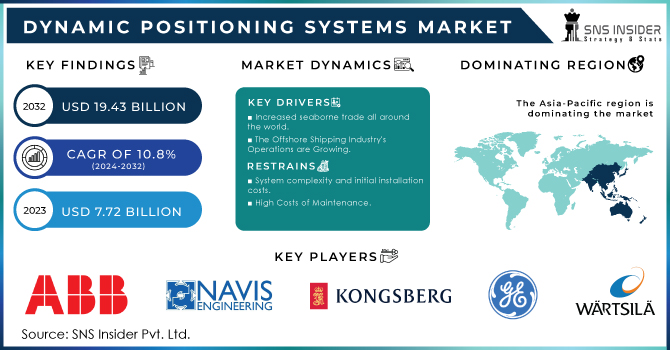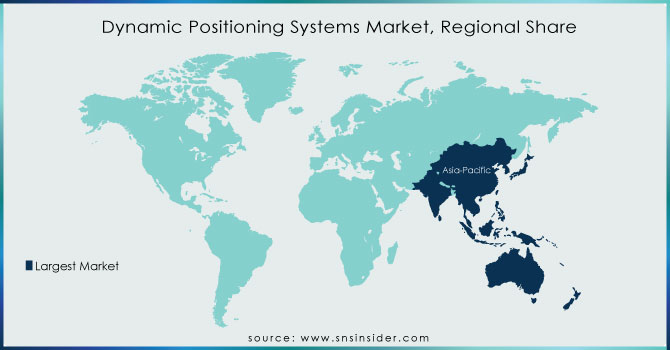Dynamic Positioning Systems Market Report Scope & Overview:

To get more information on Dynamic Positioning Systems Market - Request Free Sample Report
The Dynamic Positioning Systems Market is evaluated at USD 7.72 billion in 2023 and is expected to reach USD 19.43 billion by 2032 and grow at a CAGR of 10.8% over the forecast period 2024-2032.
Dynamic positioning systems are computer-controlled systems that keep a vessel's heading and position by using its own thruster and propellers. It permits a vessel to retain its balance on its own. Dynamic positioning systems enable vessels to operate with greater reliability, positioning accuracy, and safety. As a result, technologies like this have been widely adopted across sectors and international marine organisations like General Electric Co. and Marine Technologies LLC. However, due to previously built subsea structures on the seabed, the deployment of these systems may be limited. However, due to the length and depth of mooring lines necessary in certain Deepwater production and exploration scenarios, dynamic positioning operated vessels may be the only realistic option.
Position reference sensors, in combination with motion sensors, wind sensors, and gyrocompasses, provide information to the computer system about the position, magnitude, and direction of environmental forces, allowing the vessel to maintain its position and balance. For energy efficiency, the dynamic positioning system is combined with mooring and anchoring to form position mooring systems.
Due to a surge in the number of dynamic position vessels such as survey vessels, drilling ships, supply vessels, diving support vessels, and others, the dynamic positioning system market has seen rapid expansion in recent years. Furthermore, technical advancements and the use of dynamic positioning vessels for offshore drilling by the oil industry are increasing demand for dynamic positioning systems. However, a scarcity of qualified dynamic position operators and system complexity are limiting industry expansion. Furthermore, the installation and operation of a dynamic positioning system are important roadblocks to the DPS market's expansion.
MARKET DYNAMICS
DRIVERS
-
Increased seaborne trade all around the world
-
Advancement in technologies
-
The Offshore Shipping Industry's Operations are Growing
RESTRAINTS
-
System complexity and initial installation costs
-
High Costs of Maintenance
OPPORTUNITIES
-
Dynamic Positioning Systems Powered by Lasers
-
Shipping Industry with Self-Government
CHALLENGES
-
Unskilled Operators Have Difficulty Operating Complex Systems
IMPACT OF COVID-19
Due to a government-imposed lockdown to track the spread of COVID-19 around the world, makers of dynamic positioning systems are being forced to shut down operations. Ship and component manufacturers are experiencing supply chain disruptions as a result of government transportation restrictions imposed in the aftermath of the COVID-19 epidemic. Failure to maintain vessels, which leads to operational failure, is one of the primary difficulties facing the maritime industry. Due to sporadic breakdowns, this causes delays and hindrances in the shipping business. One of the greatest problems for engineers in doing regular repairs was travel limitations caused by the pandemic.
These issues are being addressed in order to improve the industry's current situation. The cost of shipping is high because of low demand and limited vessel availability. This pattern is predicted to persist until the pandemic is over. Countries are currently focusing on sustaining supply chains to enable running enterprises; therefore, the shipping industry is anticipated to make efforts to solve the obstacles posed by COVID-19.
By Type
During the forecast period, the next generation sector is expected to grow at the fastest rate. The rise and development of autonomous vessels will primarily drive this industry. Several governments in various locations are now working on projects to bring autonomous vessels to the commercial market. Because autonomous vessels require minimum human intervention, there is a larger risk of inaccuracy, which could result in accidents. Dynamic positioning systems are therefore required. As a result, shipowners and OEM manufacturers are developing new dynamic positioning systems for autonomous vessels. As a result, for the anticipated period, this will be the primary elements driving growth in this segment.
By Equipment Type
During the forecast period, the class 2 dynamic positioning system segment is predicted to develop at the fastest rate. Commercial vessels, such as passenger ferries, cargo ships, dredgers, and others, use class 2 dynamic positioning systems. Because the class 2 dynamic positioning system is redundant, even if the active system fails, the dynamic positioning system will not fail.
By Application
Merchant vessels, offshore vessels, passenger ships, and naval vessels make up the market. The commercial vessels application segment is expected to be the largest. The strong growth of this segment can be due to the rising use of dynamic position (DP) boats for offshore drilling by the oil and gas industries.
KEY MARKET SEGMENTATION
By Type
-
Conventional
-
Next-generation
By Equipment Type
-
Class 1
-
Class 2
-
Class 3
By Sub-System
-
Position reference and tracking system
-
DP control systems
-
Power systems
-
Motors and Drives
By Application
-
Military
-
Commercial
By End-Use
-
OEM
-
Aftermarket
REGIONAL ANALYSIS
In 2022, Asia-Pacific led the market. During the forecast period, growing economies such as China and India are expected to be the growth engines of the Asia-Pacific dynamic positioning systems market. The demand for dynamic positioning systems in the region is being driven by an increase in the number of offshore patrol vessels and technical advancements, which are the primary factors. During the projected period, North America and Europe are expected to offer significant growth prospects.

Need any customization research on Dynamic Positioning Systems Market - Enquiry Now
REGIONAL COVERAGE
-
North America
-
USA
-
Canada
-
Mexico
-
-
Europe
-
Germany
-
UK
-
France
-
Italy
-
Spain
-
The Netherlands
-
Rest of Europe
-
-
Asia-Pacific
-
Japan
-
south Korea
-
China
-
India
-
Australia
-
Rest of Asia-Pacific
-
-
The Middle East & Africa
-
Israel
-
UAE
-
South Africa
-
Rest of Middle East & Africa
-
-
Latin America
-
Brazil
-
Argentina
-
Rest of Latin America
-
KEY PLAYERS
The major key players are ABB, Navis Engineering Oy, Kongsberg Gruppen, General Electric, Wartsila Corporation, Rolls-Royce PLC, Marine Technologies LLC, Moxa Inc., L-3 Communications Holdings, Inc., Praxis Automation, Volvo Pent, and other players
Kongsberg Gruppen-Company Financial Analysis

| Report Attributes | Details |
|---|---|
| Market Size in 2023 | US$ 7.72 Billion |
| Market Size by 2032 | US$ 19.43 Billion |
| CAGR | CAGR of 10.8% From 2024 to 2032 |
| Base Year | 2023 |
| Forecast Period | 2024-2032 |
| Historical Data | 2020-2022 |
| Report Scope & Coverage | Market Size, Segments Analysis, Competitive Landscape, Regional Analysis, DROC & SWOT Analysis, Forecast Outlook |
| Key Segments | • By Type (Conventional, Next-generation) • By Equipment Type (Class 1, Class 2, Class 3) • By Sub-System (Position reference and tracking system, DP control systems, Power systems, motors, and Drives) • By Application (Military, Commercial) • By End-Use (OEM, Aftermarket) |
| Regional Analysis/Coverage | North America (USA, Canada, Mexico), Europe (Germany, UK, France, Italy, Spain, Netherlands, Rest of Europe), Asia-Pacific (Japan, South Korea, China, India, Australia, Rest of Asia-Pacific), The Middle East & Africa (Israel, UAE, South Africa, Rest of Middle East & Africa), Latin America (Brazil, Argentina, Rest of Latin America) |
| Company Profiles | ABB, Navis Engineering Oy, Kongsberg Gruppen, General Electric, Wartsila Corporation, Rolls-Royce PLC, Marine Technologies LLC, Moxa Inc., L-3 Communications Holdings, Inc., Praxis Automation, Volvo Pent, and other players. |
| DRIVERS | • Increased seaborne trade all around the world • Advancement in technologies • The Offshore Shipping Industry's Operations are Growing |
| RESTRAINTS | • System complexity and initial installation costs • High Costs of Maintenance |

